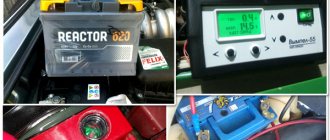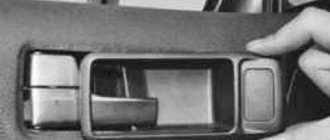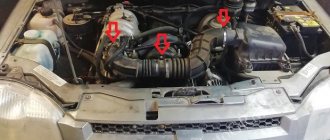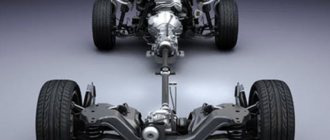At first glance, it seems that removing the battery from the car is as easy as shelling pears - unscrew a couple of nuts, take out the box, and the job is done. In reality, everything is much more complicated: you need to know some subtleties, for example, which terminal to remove first and what to do if they are stuck. Therefore, instructions on how to remove the battery from a car will be very helpful for motorists, especially beginners.
Proper removal of the battery from the car
The first thing you need to do is look at what keys you will need to remove the fastening. Typically, the fastening system is tightened with a 13 or 10 mm wrench nut.
Disabling procedure:
- Turn off the ignition, remove the key and put it in your pocket, because some cars lock the doors if you turn off the power.
- Turn off all electrical appliances: radio, headlights, air conditioning, etc.
- If the car has a ground switch installed, then after turning off the ignition key, turn off the ground.
Removing the terminals
Very important to know! The first to be removed is the (-) ground terminal.
This rule applies to all cars: injection, carburetor, diesel, with an immobilizer (IMMO), with an alarm, etc.
The negative voltage of the battery is connected to the car body. If you disconnect the terminal (minus), the car body turns off. This is important when, when removing the (plus) terminal, you accidentally touch the body with a metal object. When the ground is disconnected, no short circuit will occur.
If the ground terminal is not removed and the positive contact is accidentally closed to any metal part of the body, a short circuit will occur, as a result of which only fuses, and maybe electrical appliances, can burn out. Modern cars have electronic units that do not turn off and remain energized.
If the battery is left in the closed position for some time, it may catch fire or melt.
- Remove the (-) terminal and move the wire away. The wire has elastic deformation
- Remove the terminal (+).
- Remove the fastener and remove the battery.
It happens that the terminals are stuck, you can lightly tap them to make them come off. Oxidized deposits must be cleaned with a brush and, for example, VD-40.
How to properly remove the battery if the car has an on-board computer
After removing and installing the battery, the saved data from the on-board computer will be erased. Therefore, it is not recommended to simply not remove the battery again.
Possible problems with the alarm
Usually, removing the battery does not harm the system, but rarely the following problems may occur after disconnecting the power:
- loss of keys and remote controls;
- failure of additional alarm functions.
Possible problems with the radio
Before removing the battery from the car, you need to see if there is a security pin code on the radio. If there is a PIN code, make sure it is there. Or disable the PIN code request. As for the radio, the receiver frequencies will need to be tuned again.
Possible difficulties
Despite its outwardly primitive design, a car battery is a complex device that is sensitive to violations of operating rules. An incorrect approach during dismantling leads to failure of both the battery and other equipment connected to the vehicle’s on-board network.
To prevent a short circuit from occurring, it is necessary to remove the battery only with the engine turned off. If it is turned on, the generator runs, producing electricity. Accordingly, it is continuously supplied to the battery terminals. When the terminals are disconnected in such a situation, the voltage in the vehicle’s on-board network will increase sharply. The most optimistic outcome is a failure in the settings of the car’s electronics, alarm system, or car radio. The worst is the burnout of electrical appliances, involuntary deployment of airbags, blocking of the alarm system, melted wiring.
The procedure for removing the battery from a car does not require special skills and takes a few minutes. The main thing is to remove the battery carefully, following the sequence of disconnecting the power source from the on-board network. Remember, incorrect or careless removal of the battery from the car causes damage not only to the battery itself, but also to expensive electronics connected in a single circuit.
Safety precautions
Car batteries are heavy, so if the handle is weak, hold it by the bottom so as not to drop it.
If battery acid or electrolyte gets on your skin, immediately rinse with clean water, preferably a solution of baking soda.
Work with the battery, charge it, check the density with a hydrometer, add distilled water, etc. in a well-ventilated area. A working battery releases hydrogen gas through a special small hole in the battery housing.
Preparing for work
Before dismantling the battery, you should acquire knowledge and prepare the necessary tools.
Carrying out careless work can result in battery damage or failure of other vehicle systems.
Any work with the battery should be carried out with rubber gloves. If the hermetic integrity of the structure is violated, this will prevent electrolyte from getting on the skin.
Flammable anti-corrosion substances and the electrical charge present in the battery are also dangerous. So, to carry out work on dismantling the battery, you will need to prepare the following tools:
- rubber gloves and safety glasses;
- open-end wrench No. 10 for removing terminals;
- a wrench for unscrewing the battery fasteners (approximately No. 13, but the choice depends on the type of fasteners).
Before carrying out any operations under the hood of the car, be sure to turn off the ignition. Make sure all electrical appliances are turned off. The ignition key must be removed. Please note that some alarms have the function of locking the window and door when the power is turned off. It is better if the ignition key is in your pocket when you remove the battery, and not in the car.
Restoring vehicle on-board settings
In addition, it is necessary to ensure that all the “on-board electronics” of the machine, with the help of which the monitoring and control of its service systems are carried out, do not go astray and do not have to be restored again. When the battery is disconnected, all parameters are reset automatically.
The experience of motorists, developed while communicating with modern cars, abundantly stuffed with various types of electronics, helped to create the following algorithm of actions:
- start the engine , bring it to the usual temperature;
- turn off the engine;
- remove the terminal with the minus sign , wait three minutes;
- put it back;
- do the same with the positive terminal;
- start the engine again, let it run for 15 minutes - during this time the computer system will restore all the basic data;
- turn off the ignition - after turning it off, all information will be saved;
- start the engine again and test it in all possible modes;
- Turn off the ignition again and wait until the system records all parameters.
Now all the basic settings that were connected earlier work fine. This algorithm of action for restoring basic data on a car’s on-board system is recommended by drivers regardless of what brand of car is used. To check, you can try it on any machine and evaluate how effective it really is. The main thing is not to forget about the rules of polarity and the procedure for working with terminals.
When interacting with a battery, the main thing is not to forget how to properly remove the terminals and in what order to install them back. With a correctly removed and also correctly connected battery, no unexpected damage in the form of a short circuit will occur. And if you manage to master the independent restoration of the electronic support system, you can consider that you have mastered the full control of a modern car.
Car battery removal technology
Before you begin to understand the nuances of how to properly remove the battery from a car, you need to find where the battery is located in a specific car model. In the vast majority of cars, the battery is located in the engine compartment, to the right or left of the engine, closer to the windshield, however, such placement of the battery is not an established rule, and in some models it may be located in the luggage compartment, under the seats in the cabin or other, even unexpected “niches” of the car. You can find out where the battery is located by studying the owner's manual for the vehicle, by visually inspecting the car when instructions are not available, or by finding the answer on car forums if the first two options do not produce results.
The technology for dismantling the battery is almost identical for all brands and models of cars, however, in order to properly disconnect the battery, it is necessary to initially prepare the car for the procedure, as well as all the necessary tools and materials.
Preparing the car for the process of removing the battery consists of the need to turn off the engine, turn off all devices in the car that operate on voltage, remove the keys from the ignition and take them out of the car with you, in order to avoid the inability to get into the car if the lock is accidentally activated during the process of removing the battery.
Connecting the battery to the car
Immediately before installing the battery, it is necessary to clean the terminals with a brush. If dirt has formed on the surface of the battery, it must be removed with distilled water. Plain water cannot be used, as it may cause plaque to form.
Connect the battery in strictly reverse order:
- Place the battery in its original place.
- Tighten the fastener.
- Attach the “plus” terminal.
- Tighten the nuts with a wrench so that the structure fits tightly to the battery.
- Only after this connect the minus.
- Which terminal to remove first is “minus”. When connecting the battery back, connect the “plus” first.
The sequence of removing terminals as a prevention of rapid discharge during long-term parking
Car owners have still not come to a general conclusion about which terminal should be removed from the battery first and are conducting fierce debates on the topic “why this and not otherwise.” Essentially, the current will disappear if you turn off any of them, but it is better to look in the manual for proper guidance.
Before you start shutting down, you need to follow some simple safety precautions. Stock up on a wrench and a rag, turn off the ignition and all electrical systems. It is also better to close the doors and windows in the car. Now you can start working with the device.
It is recommended to disconnect the terminals in series. It's better to start with a minus
Experienced technicians follow the vehicle operating instructions and still recommend starting with a minus. This will reduce energy leakage and will not cause a short circuit, which can happen if you apply the key to the body.
In the case of new cars, this order is especially important, otherwise you will have to reinstall the battery through the engine control unit. Here is the answer to the question in what order to remove the terminals from the battery so as not to change the settings, damage the battery or start a fire.
Plastic covers
Plus you can leave it on or take it off. It no longer plays an important role - charging is not going anywhere, the car is de-energized. However, many advise putting special plastic covers over the terminals for safety reasons. Experts additionally recommend cleaning electrodes whose surface is susceptible to oxidation with a small piece of sandpaper.
If you are going to remove it completely: how to remove it
Some drivers prefer to prevent their car's battery from draining by removing it completely, for example when the car sits in a cold garage all winter. This is required for a completely dead battery, which cannot be charged using wires. In this case, the battery is taken home for the night and connected to electricity.
Once you have dealt with the terminals and completely de-energized the car, you can begin to disconnect the battery holders. The fasteners can go through the entire battery or under it.
We remove the battery from the car to charge it at home
Then you need to carefully remove it without spilling the electrolyte. Only an alkaline deactivator will help remove acid from the skin. This will complete the process. As you can see, there is nothing complicated about it.
Which battery terminal should be removed first?
You need to remember: the positive terminal on all vehicles is marked with a “+” sign and in red. Terminal disconnection procedure:
- The minus is disconnected first;
- the second is a plus.
The only reason for disabling in this order is banal security. Since the connected minus can cause a short circuit. For example, if you turn off the negative first, then if a key or other metal object falls on the terminal and the car body, it will lead to a short circuit.
What not to do with a battery
- damage the body;
- damage the filler plugs and their necks;
- turn the battery over or strongly tilt it;
- damage contacts (for example, by trying to force unsuitable wire terminals onto them);
- store a discharged battery (especially at sub-zero temperatures);
- add acid.
Important: if it is discovered that the electrolyte level in one or more jars is below normal, only distilled water can be added to them.
Summarizing
The information presented in the article will allow anyone, even a novice driver, to safely replace the battery, subject to all regulatory requirements for the procedure and the correct approach to performing the task.
If your car belongs to the category of elite class transport, is equipped with “complex” modern “brains”, then it is better to refrain from replacing the battery yourself, entrusting the work to specialists from car service stations, or, when the car is under warranty, contact an official service representative. Such a precaution will avoid the risk of “breakage” of the on-board computer, the cost of repairing which is far from being considered budgetary waste.











